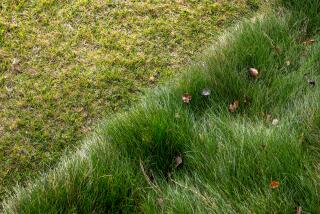GARDENING : Easy Ways to Give an Edge to Landscape
- Share via
A well-manicured yard is a pleasure to look at, but it takes a lot of work. So, most of us opt for a simple landscape that we can keep in shape without daily care.
One easy way to give a crisp look to lawn and planting beds is to make a clear separation between them with edging. Edging helps keep creeping plants in place and defines planting areas even when plants are dormant.
Sunk so that its top surface is nearly flush with the ground, it serves as a lawn-mower base. You can wheel your mower over it and eliminate hand-trimming.
There are many different types of edging made of wood or masonry. Although it cannot be used as a lawn-mower base, strip-edging of metal or plastic combined with a bed of tree bark or stone aggregate also looks neat and requires minimal maintenance. In selecting an edging material, weigh appearance, cost and ease of installation.
Wood-edging is a very easy material to install. Redwood is the most readily available wood that is naturally decay resistant. When wood is in contact with the ground, use all-heart redwood (solid colored with no light streaks of sapwood in it). All-heart cedar is also naturally decay resistant, although it may be a little more difficult to find in lumberyards.
To install 2x4 edging, first drive stakes into the ground at each end of your run. Then, stretch a string taut between the stakes for use as a guide in excavating. Use a straight spade to cut a 5 1/2-inch deep, clean-sided trench. Shovel in a two-inch bed of sand.
This helps level the edging. Install 2x4s, top edge flush with the ground, and secure them with 1x2x18-inch stakes positioned every four feet. Nail to the edging with hot-dipped, galvanized nails.
Softwood timbers that have been pressure-treated with preservative make excellent edging. Be sure to get stock designated for ground-contact use, as not all treated wood serves this purpose.
Sink large wood timbers directly into the ground or on a two-inch bed of sand. To determine your needs, multiply length by width by depth in feet or fractions of a foot to work out the number of cubic feet of sand.
Log rounds, cut two or more inches thick and four inches in diameter, make a rustic edging that can be used as a mower base when embedded in the ground, and larger rounds can serve as a raised border.
Masonry edging such as brick, tile, stone or concrete does not rot like wood and can be installed in much the same way or cast in place. If you plan curved lines, lay them out with a garden hose to see how they will look before digging the installation trench. Masonry edging should also be installed on a bed of sand or, in wet areas, on sand laid over a two-inch bed of gravel.
Brick is the most commonly used masonry edging. Install bricks flat on a two-inch bed of sand over two inches of gravel. Make the trench 6 1/4 inches deep so the top of the bricks will be flush with the grade level.






